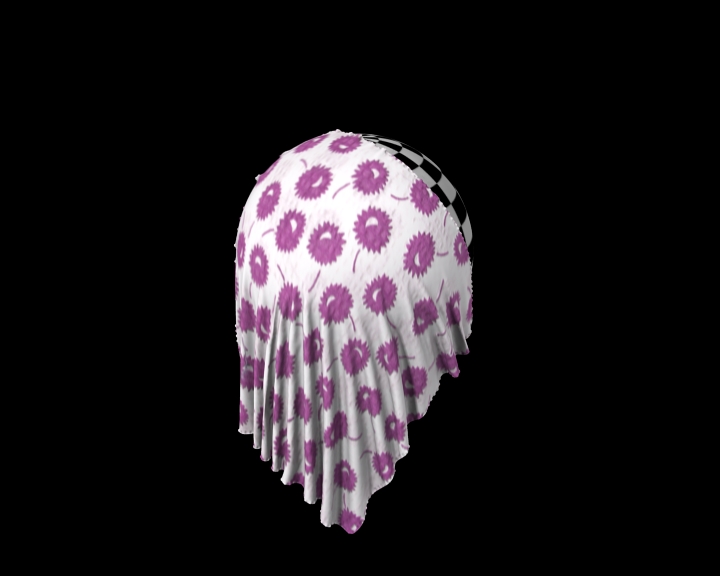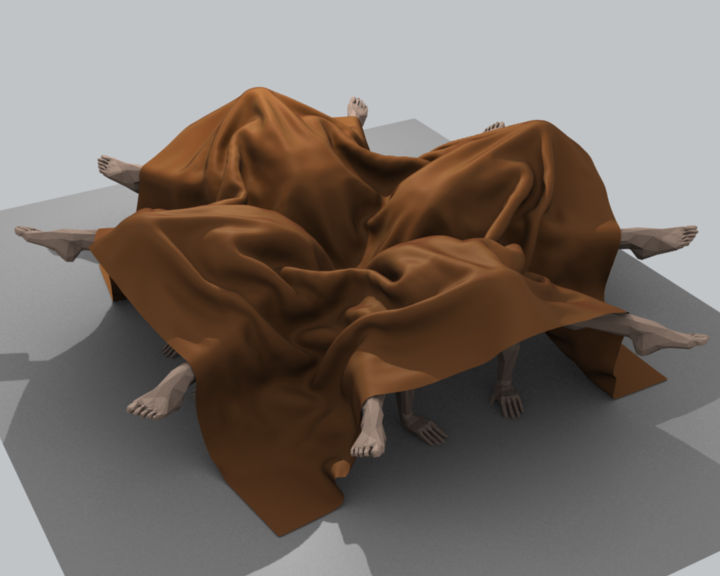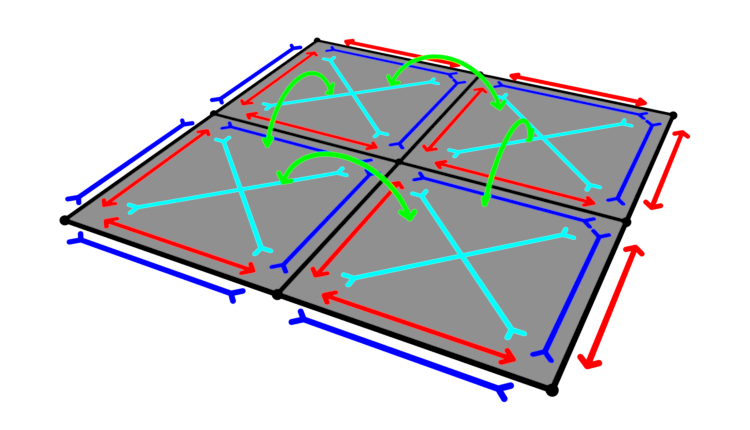Introduction – Вступ¶
Cloth simulation is one of the hardest aspects of computer graphics, it is a deceptively simple real-world item that is taken for granted, but it actually has very complex internal and environmental interactions. Cloth is commonly modeled as 2D mesh to simulate real world objects such as fabrics, flags, banners. And yet cloth can also be used to model 3D objects such as teddy bears, pillows, balloons, or balls.
Тканина взаємодіє іншими рухомими об’єктами та задіюється ними, вітром та іншими силами, а також загальною аеродинамічною моделлю, і цим всім ви можете керувати.

Приклад симуляції тканини.¶ |

Тканина на різьблених дерев’яних чоловічках (зроблено митцем motorsep).¶ |

Приклад симуляції тканини.¶ |
Once Cloth physics have been added to a mesh, a Cloth Modifier will be added to the object’s modifier stack. As a modifier then, it can interact with other modifiers, such as Armature and Smooth. In these cases, the ultimate shape of the mesh is computed in accordance with the order of the modifier stack. For example, you should smooth the cloth after the modifier computes the shape of the cloth.
You can Apply the Cloth Modifier to freeze, or lock in, the shape of the mesh at that frame, which removes the modifier. For example, you can drape a flat cloth over a table, let the simulation run, and then apply the modifier. In this sense, you are using the simulator to save yourself a lot of modeling time.
Results of the simulation are saved in a cache, so that the shape of the mesh, once calculated for a frame in an animation, does not have to be recomputed again. If changes to the simulation are made, you have full control over clearing the cache and re-running the simulation. Running the simulation for the first time is fully automatic and no baking or separate step interrupts the workflow.
Computation of the shape of the cloth at every frame is automatic and done in the background; thus you can continue working while the simulation is computed. However, it is CPU-intensive and depending on the power of your PC and the complexity of the simulation, the amount of CPU needed to compute the mesh varies, as does the lag you might notice.
Примітка
Не забігайте наперед
Якщо ви уклали симуляцію тканини, але Blender ще не обчислив її форми у ході симуляції, та, якщо ви перейдете вперед на багато кадрів по вашій анімації, то імітатор тканини може не бути у змозі обчислити або показати вам точну форму сіті у такому кадрі, якщо ще не обчислено її форму у попередніх кадрі(ах).
Workflow – Робпотік¶
Загальний процес для роботи з тканиною є наступним:
Змоделюйте звичайним чином тканинний об’єкт у загальній стартовій формі.
Designate the object as a «cloth» in the Physics tab of the Properties.
Model other deflection objects that will interact with the cloth. Ensure the Deflection modifier is last on the modifier stack, after any other mesh deforming modifiers.
Освітіть цю тканину, при потребі розгорніть її поверхню по UV, та призначте для неї матеріали та текстури.
За бажанням додайте для цього об’єкта систему частинок, що наприклад, симулює випаровування пари з тканинної поверхні.
Run the simulation and adjust settings to obtain satisfactory results. The Timeline editors playback controls are great for this step.
Факультативно зафіксуйте (застосуйте модифікатор) у певному моменті симуляції для отримання нової стандартної стартової форми.
Зробіть дрібні редагування для сіті кадр-за-кадром з метою корекції незначних огріхів.
Порада
Для уникання нестабільної симуляції переконайтеся, що об’єкт тканини не проникає та не перетинається з іншими об’єктами відхилення.
Пружності – Springs¶
Internally, cloth physics is simulated with virtual springs that connect the vertices of a mesh. There are four types of springs that control how the cloth bends. These four types are defined below and illustrated in the following image:

Ілюстрація пружностей тканини; пружності натягу (сині), пружності стиснення (червоні), пружності косування (блакитні) та пружності кутового згинання (зелені).¶
- Пружності Натягу – Tension Springs
Керують тугістю тканини.
- Пружності Стиснення – Compression Springs
Керують величиною сили, що вимагається для стягнення або стискання тканини.
- Пружності Косування – Shear Springs
Як і пружності стиснення, але це керує кутовою деформацією.
- Пружності Кутового Згинання – Angular Bending Springs
Керують тим, наскільки пружна тканина до згортування або зморщування.
All four of these spring types can be controlled independently in the Фізичні Властивості – Physical Properties panel. While these settings control surface springs, optionally, internal springs can be used for 3D meshes and behave similarly to Soft Bodies.